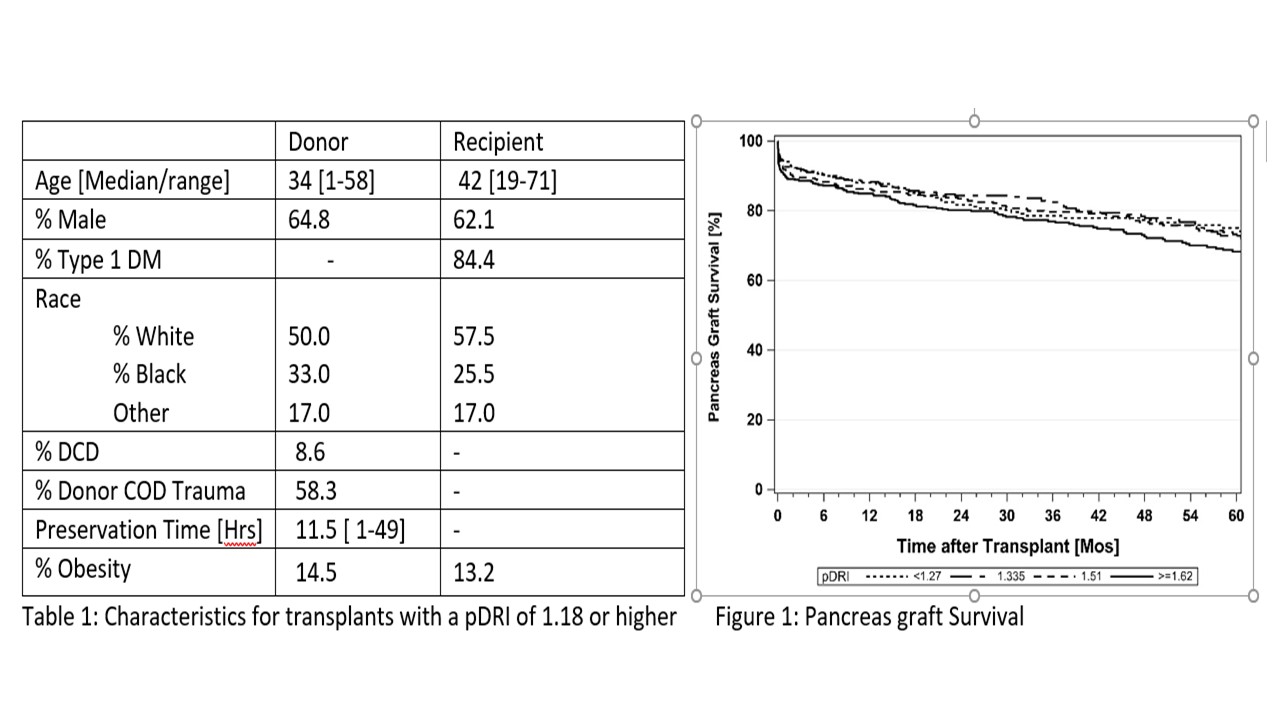Outcome of and Risk Factor for Pancreas Transplants with Marginal Donors
SUNY Downstate Medical Center, Brooklyn, NY
Meeting: 2020 American Transplant Congress
Abstract number: 401
Keywords: Donors, marginal, Outcome, Pancreas transplantation
Session Information
Session Name: Pancreas and Islet: All Topics I
Session Type: Oral Abstract Session
Date: Saturday, May 30, 2020
Session Time: 3:15pm-4:45pm
 Presentation Time: 4:03pm-4:15pm
Presentation Time: 4:03pm-4:15pm
Location: Virtual
*Purpose: Over the years, the selection criteria for a pancreas donor changed with the decline in numbers of transplants. More and more younger donors with very short preservation time are chosen. Outcome of, and risk factor for, pancreas transplants with marginal donors have not been studied in detail. We defined a marginal donor pancreata as one out of the 4th quartile of the pDRI distribution. Those are the pancreata with the lowest donor quality.
*Methods: 1,674 primary SPK transplants with a pDRI over 1.18 (4th quartile of all primary SPK transplants) reported to UNOS/OPTN and performed between 2010 and 2018 were included in this study. To assess the impact of the pDRI within this group, we divided those pancreata again into 4 equal sized groups. Comprehensive uni- and multivariate analyses were performed to describe patient and graft survival and to identify additional risk factors.
*Results: Table 1 shows the basic characteristics of the analyzed transplants. Most of the transplants were performed at high volume centers (in 79%). Stratification of the marginal donors into 4 groups had no impact on overall good outcomes. One- (5 year) patient survival was between 96.8% (87.3%) to 97.7% (87.8%) (p=0.74). Figure 1 shows the pancreas graft survival. One-(5) year pancreas graft survival was between 88.4% (74.3%) and 84.9% (68.2%) (p=0.32); for kidney grafts survival the 1- (5-) year survival rates were between 95.6% (85.2%) and 95.3% (79.7%) (p=0.57). While the pancreata could be classified as marginal, the kidney graft were still “SCD”. The multivariate analyses showed that the most influential risk factors for early technical failures and also for 1-year pancreas graft function were extended preservation time, recipient obesity, and low center volume. Donor age, gender, BMI, DCD status, race, and HLA-match did not impact outcome. The survival rates in recipients < 30 years were higher compared to older recipients; a high cPRA carried also a significantly increased risk for graft failure..
*Conclusions: Our study showed surprisingly successful patient and graft outcome even for low quality pancreata (4th quartile pDRI pancreata). Thus, criteria determining discard rates of lower quality pancreata may need to be revised.
To cite this abstract in AMA style:
Gruessner A, Saggi S, Renz J, Gruessner R. Outcome of and Risk Factor for Pancreas Transplants with Marginal Donors [abstract]. Am J Transplant. 2020; 20 (suppl 3). https://atcmeetingabstracts.com/abstract/outcome-of-and-risk-factor-for-pancreas-transplants-with-marginal-donors/. Accessed December 29, 2025.« Back to 2020 American Transplant Congress

